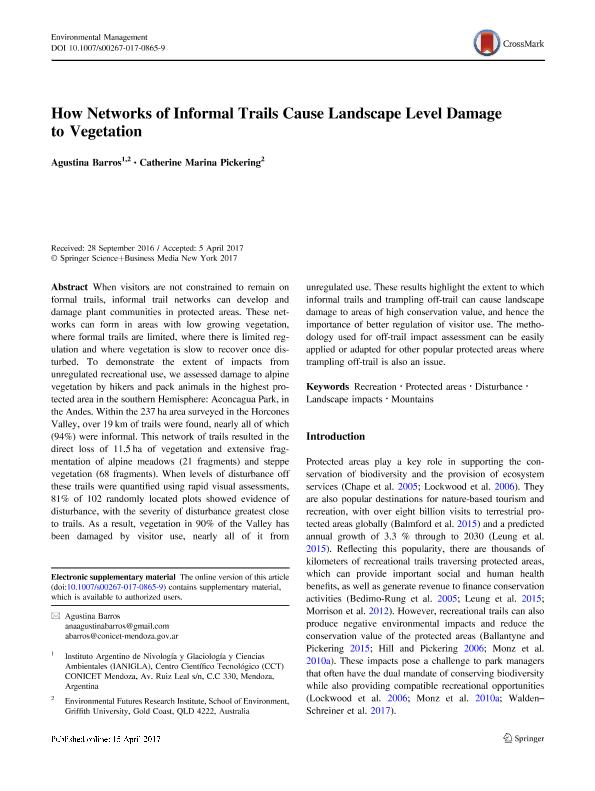Mostrar el registro sencillo del ítem
dc.contributor.author
Barros, Ana Agustina

dc.contributor.author
Pickering, Catherine Marina

dc.date.available
2018-11-09T14:55:24Z
dc.date.issued
2017-07
dc.identifier.citation
Barros, Ana Agustina; Pickering, Catherine Marina; How Networks of Informal Trails Cause Landscape Level Damage to Vegetation; Springer; Environmental Management; 60; 1; 7-2017; 57-68
dc.identifier.issn
0364-152X
dc.identifier.uri
http://hdl.handle.net/11336/64072
dc.description.abstract
When visitors are not constrained to remain on formal trails, informal trail networks can develop and damage plant communities in protected areas. These networks can form in areas with low growing vegetation, where formal trails are limited, where there is limited regulation and where vegetation is slow to recover once disturbed. To demonstrate the extent of impacts from unregulated recreational use, we assessed damage to alpine vegetation by hikers and pack animals in the highest protected area in the southern Hemisphere: Aconcagua Park, in the Andes. Within the 237 ha area surveyed in the Horcones Valley, over 19 km of trails were found, nearly all of which (94%) were informal. This network of trails resulted in the direct loss of 11.5 ha of vegetation and extensive fragmentation of alpine meadows (21 fragments) and steppe vegetation (68 fragments). When levels of disturbance off these trails were quantified using rapid visual assessments, 81% of 102 randomly located plots showed evidence of disturbance, with the severity of disturbance greatest close to trails. As a result, vegetation in 90% of the Valley has been damaged by visitor use, nearly all of it from unregulated use. These results highlight the extent to which informal trails and trampling off-trail can cause landscape damage to areas of high conservation value, and hence the importance of better regulation of visitor use. The methodology used for off-trail impact assessment can be easily applied or adapted for other popular protected areas where trampling off-trail is also an issue.
dc.format
application/pdf
dc.language.iso
eng
dc.publisher
Springer

dc.rights
info:eu-repo/semantics/openAccess
dc.rights.uri
https://creativecommons.org/licenses/by-nc-sa/2.5/ar/
dc.subject
Disturbance
dc.subject
Landscape Impacts
dc.subject
Mountains
dc.subject
Protected Areas
dc.subject
Recreation
dc.subject.classification
Otras Ciencias Biológicas

dc.subject.classification
Ciencias Biológicas

dc.subject.classification
CIENCIAS NATURALES Y EXACTAS

dc.title
How Networks of Informal Trails Cause Landscape Level Damage to Vegetation
dc.type
info:eu-repo/semantics/article
dc.type
info:ar-repo/semantics/artículo
dc.type
info:eu-repo/semantics/publishedVersion
dc.date.updated
2018-10-23T14:43:44Z
dc.journal.volume
60
dc.journal.number
1
dc.journal.pagination
57-68
dc.journal.pais
Alemania

dc.journal.ciudad
Berlin
dc.description.fil
Fil: Barros, Ana Agustina. Consejo Nacional de Investigaciones Científicas y Técnicas. Centro Científico Tecnológico Conicet - Mendoza. Instituto Argentino de Nivología, Glaciología y Ciencias Ambientales. Provincia de Mendoza. Instituto Argentino de Nivología, Glaciología y Ciencias Ambientales. Universidad Nacional de Cuyo. Instituto Argentino de Nivología, Glaciología y Ciencias Ambientales; Argentina. Griffith University; Australia
dc.description.fil
Fil: Pickering, Catherine Marina. Griffith University; Australia
dc.journal.title
Environmental Management

dc.relation.alternativeid
info:eu-repo/semantics/altIdentifier/doi/https://dx.doi.org/10.1007/s00267-017-0865-9
dc.relation.alternativeid
info:eu-repo/semantics/altIdentifier/url/https://link.springer.com/article/10.1007/s00267-017-0865-9
Archivos asociados
